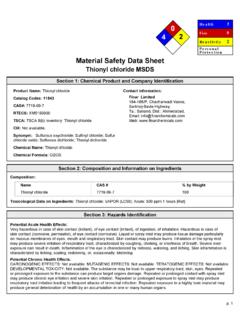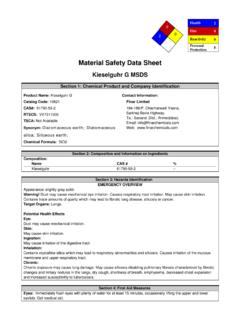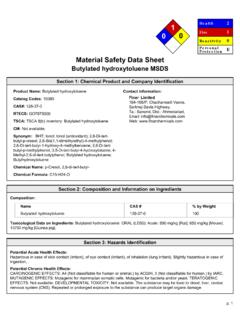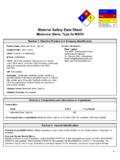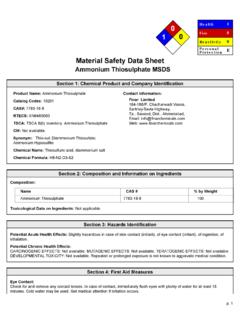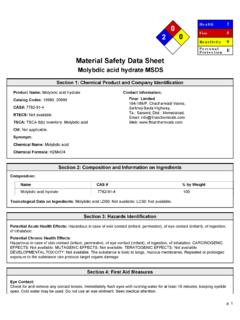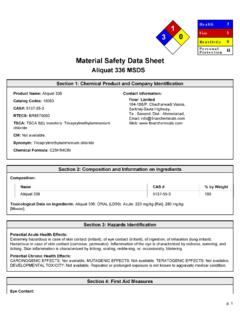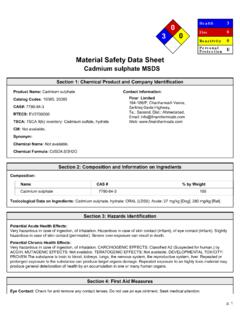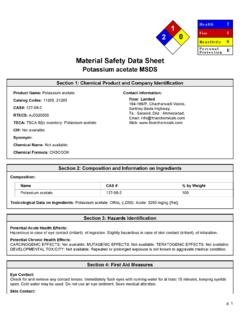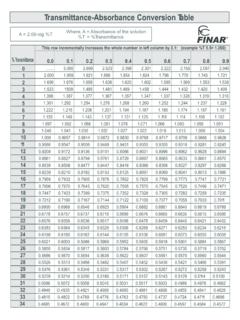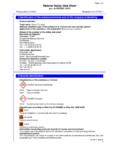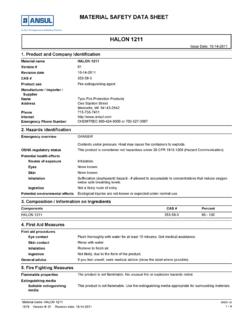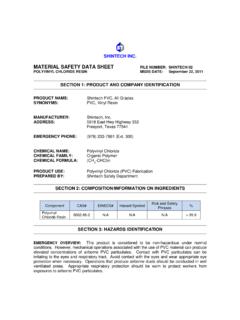Transcription of Material Safety Data Sheet - Finar Chemicals Ltd.
1 P. 1 3 3 0He a lt hFireRe a c t iv it yP e rs o n a lP ro t e c t io n330 Material Safety data Sheet N-Methyl morpholine MSDSS ection 1: Chemical Product and Company IdentificationProduct Name: 4-Methyl morpholineCatalog Codes: 10958 CAS#: 109-02-4 RTECS: QE5775000 TSCA: TSCA 8(b) inventory: 4-MethylmorpholineCI#: Not : N-Methylmorpholine; morpholine, 4-methyl-; 4-Methyl-1-oxa-4-azacyclohexaneChemical Name: 4-MethylmorpholineChemical Formula: C5-H11-N-OContact Information: Finar Limited184-186/P, Chacharwadi Vasna, Sarkhej-Bavla Highway, Ta.: Sanand, Dist.: Ahmedabad, Email: Web: 2: Composition and Information on IngredientsComposition:NameCAS #% by Weight4-Methylmorpholine109-02-4100 Toxicological data on Ingredients: 4-Methylmorpholine: ORAL (LD50): Acute: 1960 mg/kg [Rat]. 1970 mg/kg [Mouse].DERMAL (LD50): Acute: 1820 mg/kg [Rat]. VAPOR (LC50): Acute: 25200 mg/m 2 hours [Mouse].Section 3: Hazards IdentificationPotential Acute Health Effects:Very hazardous in case of skin contact (irritant), of eye contact (irritant).
2 Hazardous in case of skin contact (permeator), ofingestion, of inhalation. Slightly hazardous in case of skin contact (corrosive), of eye contact (corrosive). Liquid or spraymist may produce tissue damage particularly on mucous membranes of eyes, mouth and respiratory tract. Skin contact mayproduce burns. Inhalation of the spray mist may produce severe irritation of respiratory tract, characterized by coughing,choking, or shortness of breath. Inflammation of the eye is characterized by redness, watering, and itching. Skin inflammationis characterized by itching, scaling, reddening, or, occasionally, Chronic Health Effects:Slightly hazardous in case of skin contact (sensitizer). CARCINOGENIC EFFECTS: Not available. MUTAGENIC EFFECTS:Not available. TERATOGENIC EFFECTS: Not available. DEVELOPMENTAL TOXICITY: Not available. The substance may betoxic to lungs. Repeated or prolonged exposure to the substance can produce target organs damage.
3 Repeated or prolongedcontact with spray mist may produce chronic eye irritation and severe skin irritation. Repeated or prolonged exposure to spraymist may produce respiratory tract irritation leading to frequent attacks of bronchial 2 Section 4: First Aid MeasuresEye Contact:Check for and remove any contact lenses. In case of contact, immediately flush eyes with plenty of water for at least 15minutes. Cold water may be used. Get medical attention Contact:In case of contact, immediately flush skin with plenty of water for at least 15 minutes while removing contaminated clothingand shoes. Cover the irritated skin with an emollient. Cold water may be clothing before reuse. Thoroughly cleanshoes before reuse. Get medical attention Skin Contact:Wash with a disinfectant soap and cover the contaminated skin with an anti-bacterial cream. Seek immediate :If inhaled, remove to fresh air. If not breathing, give artificial respiration. If breathing is difficult, give oxygen.
4 Get medicalattention Inhalation:Evacuate the victim to a safe area as soon as possible. Loosen tight clothing such as a collar, tie, belt or waistband. Ifbreathing is difficult, administer oxygen. If the victim is not breathing, perform mouth-to-mouth resuscitation. WARNING: It maybe hazardous to the person providing aid to give mouth-to-mouth resuscitation when the inhaled Material is toxic, infectious orcorrosive. Seek immediate medical :Do NOT induce vomiting unless directed to do so by medical personnel. Never give anything by mouth to an unconsciousperson. If large quantities of this Material are swallowed, call a physician immediately. Loosen tight clothing such as a collar,tie, belt or Ingestion: Not 5: Fire and Explosion DataFlammability of the Product: Temperature: 165 C (329 F)Flash Points: CLOSED CUP: C (75 F).Flammable Limits: LOWER: UPPER: of Combustion: These products are carbon oxides (CO, CO2), nitrogen oxides (NO, ).
5 Fire Hazards in Presence of Various Substances:Highly flammable in presence of open flames and sparks, of heat. Non-flammable in presence of Hazards in Presence of Various Substances:Risks of explosion of the product in presence of mechanical impact: Not available. Risks of explosion of the product inpresence of static discharge: Not available. Slightly explosive in presence of Fighting Media and Instructions:Flammable liquid, soluble or dispersed in water. SMALL FIRE: Use DRY chemical powder. LARGE FIRE: Use alcohol foam,water spray or Remarks on Fire Hazards:When heated to decomposition it emits highly toxic and irritating fumes. Vapor may travel considerable distance to source ofignition and flash Remarks on Explosion Hazards:Can release vapors that form explosive mixtures at temperatures above the flash point. Vapors may form explosive mixtureswith airp. 3 Section 6: Accidental Release MeasuresSmall Spill:Dilute with water and mop up, or absorb with an inert dry Material and place in an appropriate waste disposal container.
6 Ifnecessary: Neutralize the residue with a dilute solution of acetic Spill:Flammable liquid. Corrosive liquid. Keep away from heat. Keep away from sources of ignition. Stop leak if without risk. Absorbwith DRY earth, sand or other non-combustible Material . Do not get water inside container. Do not touch spilled water spray curtain to divert vapor drift. Prevent entry into sewers, basements or confined areas; dike if needed. Call forassistance on disposal. Neutralize the residue with a dilute solution of acetic 7: Handling and StoragePrecautions:Keep container dry. Keep away from heat. Keep away from sources of ignition. Ground all equipment containing not ingest. Do not breathe gas/fumes/ vapor/spray. Never add water to this product. In case of insufficient ventilation,wear suitable respiratory equipment. If ingested, seek medical advice immediately and show the container or the label. Avoidcontact with skin and eyes. Keep away from incompatibles such as oxidizing agents, :Store in a segregated and approved area.
7 Keep container in a cool, well-ventilated area. Keep container tightly closed andsealed until ready for use. Avoid all possible sources of ignition (spark or flame).Section 8: Exposure Controls/Personal ProtectionEngineering Controls:Provide exhaust ventilation or other engineering controls to keep the airborne concentrations of vapors below their respectivethreshold limit value. Ensure that eyewash stations and Safety showers are proximal to the work-station Protection:Face shield. Full suit. Vapor respirator. Be sure to use an approved/certified respirator or equivalent. Gloves. Protection in Case of a Large Spill:Splash goggles. Full suit. Vapor respirator. Boots. Gloves. A self contained breathing apparatus should be used to avoidinhalation of the product. Suggested protective clothing might not be sufficient; consult a specialist BEFORE handling Limits: Not 9: Physical and Chemical PropertiesPhysical state and appearance: : Ammoniacal.
8 (Strong.)Taste: Not Weight: g/moleColor: Clear (1% soln/water): [Basic.]Boiling Point: 115 C (239 F)Melting Point: C (-87 F)Critical Temperature: Not 4 Specific Gravity: (Water = 1)Vapor Pressure: kPa (@ 20 C)Vapor Density: (Air = 1)Volatility: Not Threshold: Not Dist. Coeff.: Not (in Water): Not Properties: See solubility in : Soluble in cold 10: Stability and Reactivity DataStability: The product is Temperature: Not of Instability: Heat, ignition sources (flames, sparks, static), incompatible materialsIncompatibility with various substances: Reactive with oxidizing agents, : Not Remarks on Reactivity: Incompatible with acid anhydrides, acid chlorides, carbon dioxideSpecial Remarks on Corrosivity: Not : Will not 11: Toxicological InformationRoutes of Entry: Absorbed through skin. Dermal contact. Eye contact. Inhalation. to Animals:WARNING: THE LC50 VALUES HEREUNDER ARE ESTIMATED ON THE BASIS OF A 4-HOUR EXPOSURE.
9 Acute oraltoxicity (LD50): 1960 mg/kg [Rat]. Acute dermal toxicity (LD50): 1820 mg/kg [Rat]. Acute toxicity of the vapor (LC50): 25200mg/m 2 hours [Mouse]. 3 Chronic Effects on Humans: May cause damage to the following organs: Toxic Effects on Humans:Very hazardous in case of skin contact (irritant). Hazardous in case of skin contact (permeator), of ingestion, of inhalation (lungcorrosive). Slightly hazardous in case of skin contact (corrosive), of eye contact (corrosive).Special Remarks on Toxicity to Animals:Lethal Dose/Conc 50% Kill LD50 [Rabbit] - Route: Skin; Dose: 1350 ul/kgSpecial Remarks on Chronic Effects on Humans: Not Remarks on other Toxic Effects on Humans:Acute Potential Health Effects: Skin: Causes skin irritation and possible burns. May be absorbed through the skin in harmfulamounts. Eyes: Causes eye irritation with possible burns. May cause conjunctivitis. Inhalation: Causes respiratory tractirritation. Irritation may lead to chemical pneumonitis and pulmonary edema.
10 Ingestion: Causes gastrointestinal tract irritationwith nausea, vomitting and diarrhea. Chronic Potential Health Effects: Skin: Prolonged or repeated skin contact may causedefatting and 12: Ecological Informationp. 5 Ecotoxicity: Not and COD: Not of Biodegradation:Possibly hazardous short term degradation products are not likely. However, long term degradation products may of the Products of Biodegradation: The products of degradation are less toxic than the product Remarks on the Products of Biodegradation: Not 13: Disposal ConsiderationsWaste Disposal:Waste must be disposed of in accordance with federal, state and local environmental control 14: Transport InformationDOT Classification:CLASS 3: Flammable liquid. Class 8: Corrosive materialIdentification: : 4-Methylmorpholine UNNA: 2535 PG: IISpecial Provisions for Transport: Not 15: Other Regulatory InformationFederal and State Regulations:Pennsylvania RTK: 4-Methylmorpholine Florida: 4-Methylmorpholine Massachusetts RTK: 4-Methylmorpholine New Jersey: 4-Methylmorpholine TSCA 8(b) inventory: 4-MethylmorpholineOther Regulations:OSHA: Hazardous by definition of Hazard Communication Standard (29 CFR ).
